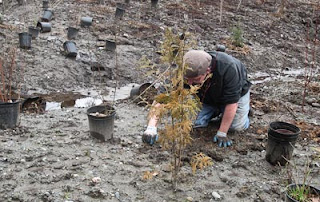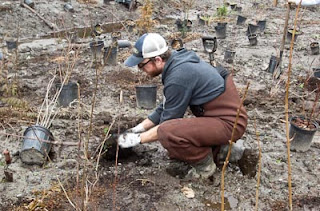By Shawna Lee, Clearwater staff member
Work is nearing completion on the North Creek Clearwater Reach stream restoration project.
The final phase of the project involves planting thousands of
native trees and shrubs in the riparian zones at both The Clearwater
School and Clearwater Commons. Scott Moore, Native Plant Steward at
Snohomish County Surface Water Management, created a planting plan and
plant list to re-vegetate the construction area.
Shrubs awaiting planting on west side of North Creek
In the late fall, members of the Washington Conservation Corps
(WCC) planted 1,000 trees on both sides of North Creek running through school property.
Hundreds more shrubs on the eastern slope of North Creek
In
early February, 3,000 shrubs were delivered and placed. WCC did much of
the planting, and last week members of that crew trained Clearwater students and staff how to plant the remaining
several hundred shrubs to ensure a high survival rate. We have this week
and next to finish the planting.
WCC crew member explaining technique to Justin, Lily and Tommie
...and they set to work
Mat Riggle speed planting in the mud
Robert and Lucas were a close second and third at 28 and 26 plants in one hour, respectively.
Robert--boots are essential
Lucas digging yet another hole
We love dreaming of and imagining how the landscape will look in 2, 5 and 10 years as the trees and shrubs grow and provide shade, habitat and beauty. The stream-side land will become a forest.
Delayney at work
Matt Garrity with his excellent warm and waterproof overalls
The restoration project is the result of a partnership between Snohomish County, Clearwater Commons and The Clearwater School, to enhance and protect natural habitat along a 1400-foot stretch of North Creek that flows through adjacent school and Clearwater Commons properties.
Joey teases apart dogwood roots
Snohomish County received a grant for $75,000 from the National Fish and Wildlife Foundation to restore more natural stream flow and native wildlife habitat in the Clearwater Reach. First, large machines removed tons of fill dirt covering the natural flood plain and removed or relocated large, stream-choking boulders that had been placed decades ago to minimize flooding.
Removing 7-foot-deep fill dirt to expose flood plain
Bank terracing complete and ready for planting
The heavy construction work, completed late last summer, installed quantities of large woody debris to slow the current and provide habitat. Now the creek can spread out during winter rainy periods and creek bed scouring should be reduced--allowing silt deposits to build up for salmon egg nests.
North Creek can spread out during heavy rains
The Clearwater Reach of North Creek will not only be more hospitable for spawning salmon but other native wildlife, including stream invertebrates, amphibians, freshwater mussels and varied plant communities. North Creek currently supports sockeye, Chinook and Coho salmon species.
Large woody debris and stone riffle
Our goal is to show that individuals, schools and government entities
can work successfully together to create better wildlife and human habitat. We
hope our involvement in this effort will inspire future projects in
other locations.
Stephanie Sarantos and Gabriel
Carrying pots of wood mulch for trees and shrubs
Joey and Lucas


















No comments:
Post a Comment